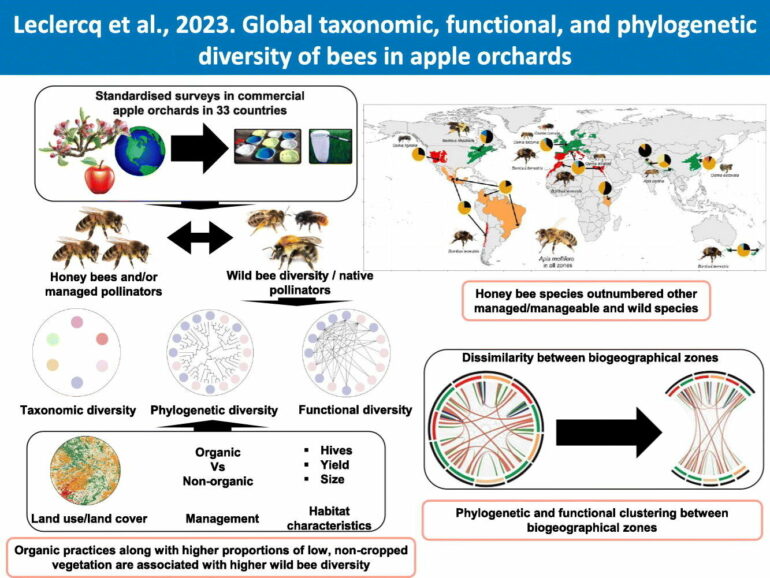By carrying pollen from flower to flower, pollinator insects play an essential role in the reproductive cycle of flowering plants. Bees do more of it than any other, both here in Canada and around the world.
Unfortunately, their numbers are in decline, for a variety of reasons: exposure to pesticides, disease, climate change, habitat destruction and agriculture. And without bees, you can say goodbye to many of the fruits, berries, oils and nuts you eat.
To understand the situation and find ways to protect these vital species, an international research team investigated the characteristics of bee communities globally. Specifically, they studied those found in apple orchards, the world’s most common outdoor monoculture.
Published in August in Science of the Total Environment, their work covered the flowering season of 177 commercial apple orchards in 33 countries, including Canada, across six continents.
Some of those orchards were in the Eastern Townships near Montreal, and that’s where Étienne Normandin, an entomologist and coordinator of Université de Montréal’s zoological and entomological collections, went to gather data.
Significant homogeneity
His team observed significant heterogeneity in the composition of bee communities across the Townships orchards. But they also found that within a single region, bees display similar functional and behavioral traits. “There’s a homogenization of functional diversity,” Normandin said.
“The characteristics of the dominant bee species are overrepresented compared to those of other species,” he noted, pointing out how that’s not a good sign. “In nature, diversity is always best—otherwise there’s a loss of resilience and the ability to adapt to changes in the environment, such as those caused by climate change.”
Also of note: in every biogeographical zone they studied, the researchers found honey bees. Native to Europe, they’re considered a domesticated species, raised extensively in apiaries for their honey.
“There’s a risk to importing domesticated bees for farming, since they often carry pathogens that are transmitted to other types of bees and other insects,” Normandin explained.
Some positive news
The study made some positive findings as well: where there are fallow grassy areas around orchards and where organic, pesticide-reducing practices are used, the wild bee populations are more diverse.
“Big crops like apple orchards tend to create a lot of resources for bees, a lot of flowers that produce nectar and pollen,” explained Normandin. “After the flowering period—which usually lasts about a week and a half—the pollinators stay in the orchard and must find food to ensure the survival of the next generation in the hive.
“That’s why it’s important for them to have a wide variety of other plants to feed on. If you only have a few bee species in the orchard and they can only pollinate a few plants, those plants will have a competitive advantage. That could potentially lead to changes to the ecosystem.”
While the study was designed primarily as a survey of global bee diversity, the results suggest that further research is needed to develop effective management and conservation strategies for these essential insects.
“By increasing our knowledge of bee diversity, we’ll be able to develop targeted approaches to protect pollinators and promote sustainable agricultural practices,” said Normandin. “The study provides a snapshot of current global bee populations and a baseline for measuring their decline in the future.”
More information:
N. Leclercq et al, Global taxonomic, functional, and phylogenetic diversity of bees in apple orchards, Science of The Total Environment (2023). DOI: 10.1016/j.scitotenv.2023.165933
Provided by
University of Montreal
Citation:
International study characterizes diversity of bees in apple orchards across the globe (2023, October 2)
